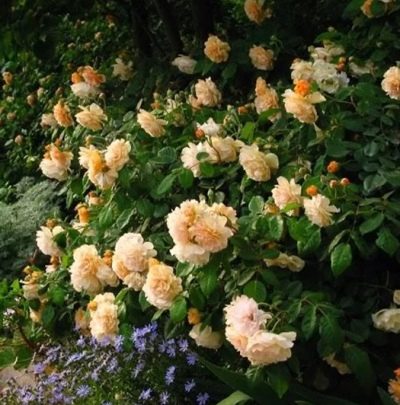
- Name synonyms: Buff Beauty, Buff Beauty
- Group: climbing, musky
- The main color of the flower: orange
- Flower shape: cupped
- Flower size: large
- Diameter, cm: 7-8
- Flower type by number of petals: thick double
- Scent: tea rose with fruity notes of bananas and ripe apples
- Description of the bush: vigorous, spreading, fountain-like, moderately thorny, with arcuate drooping shoots
- Bush height, cm: 150-300
Rose Buff Beauty has been around for many years. Over the years, she managed to win the love and recognition of gardeners. She is chosen for her presentable appearance and non-capricious care.
Breeding history of the variety
The rose variety in question appeared thanks to the efforts of the famous breeder Pemberton. However, the flower was revealed to the world only 13 years after its breeding, in 1939. It was introduced by Pemberton's heiress, Anne Bentall. In 1993 the Rose was awarded the Garden Merit by the Royal Horticultural Society. In addition, the flower has won awards at two exhibitions from the American Rose Society.
Description of the variety
Buff Beauty is ranked among the hybrids from the group of musky, climbing roses. The plant is moderately prickly, with thorns, vigorous, spreading, resembles a fountain in appearance. It is characterized by drooping reddish shoots in the shape of an arc. Above the ground, the bush can rise 150-300 centimeters, its width is 150 centimeters. The leaves of a young rose have a scarlet hue, later they become rich green, hard and large.
The Buff Beauty colors range from yellow-orange to creamy apricot with a darker center.
Advantages and disadvantages
As the advantages of the described hybrid, one can note the elementary rules of caring for it, resistance to fungal diseases, pests, low temperatures and rains. In addition, the flower pleases the owner with a delicate and strong scent of a tea rose with pleasant apple and banana notes. Buff Beauty has few disadvantages, they are mainly associated with flowering - the lack of flowering density, poor flowering due to an excess of sunny color, since it is not always possible to provide the flower with partial shade.
Flowering features
Subject to the rules of care, the hybrid blooms continuously from June to the autumn cold. The bloom is in full bloom in September. Flowers are densely double, cupped in shape, of impressive size. Each stem has 8-12 flowers. Their diameter is 7-8 centimeters. Each flower has 40-50 petals. The roses on the bush are located not only one at a time, but also form inflorescences.
Use in landscape design
The described variety is excellently combined with other types of plants in mixborders, looks good near the wall, on a steep slope or in a single version in the background of the garden.
Growing regions
Recommended for cultivation in the Central, North-West and other regions of Russia.
Landing
When starting planting, it is advised to adhere to the scheme: place two flowers on one square meter.
Growing and care
Planting a rose is advised in the spring or autumn. It is better to choose a place in partial shade, on a fertile, organic-rich plot of land. For planting, you need to dig a hole 60 centimeters deep. If the soil is sandy, a layer of clay 20 centimeters thick is poured onto the bottom of the pit. The flower must be systematically watered, as needed - fertilized, cut and slightly spud. Blooming roses may need support.
Watering and feeding
The hybrid should be irrigated about a couple of times a week; with the onset of cold weather, the frequency of watering is reduced.It is advisable to feed Buff Beauty after pruning, you can introduce a solution of ammonium nitrate into the soil.
Pruning
This procedure is usually carried out in the springtime. The main unripe shoots are cut off, the lateral ones retain up to 5 buds.
Frost resistance and preparation for winter
Buff Beauty has excellent frost resistance, it is adapted to frosts down to -29 degrees Celsius. But despite this, in the fall, gardeners begin to prepare the rose for winter. To do this, you need to stop fertilizing and watering the flower, and prepare a shelter.
Diseases and pests
The hybrid shows an average resistance to ailments and pests. The rose can get sick with powdery mildew, be attacked by caterpillars, rose-colored aphids or cicadas. For the treatment of plants, herbal decoctions, chemical preparations are used.
Reproduction
Reproduction of Buff Beauty occurs by means of root shoots, cuttings or grafting on the stock.
Review overview
Most gardeners speak positively about the above-described variety. They note the beauty and pleasant aroma of the flower, ease of care and the ability to withstand the cold.































































